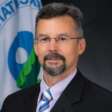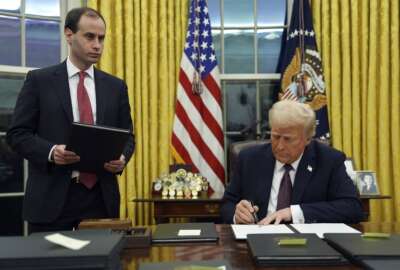Workplace Reimagined 2023: EPA CIO Vaughn Noga on fine-tuning IT infrastructure for hybrid
Through process changes, technology adoption and continued efforts to be flexible, Health and Human Services has cut its time to hire by 50%. But CHCO Bob Leavitt...
The Environmental Protection Agency’s Vaughn Noga likes to say that if you are talking about the need to modernize aging infrastructure, it’s already too late.
What the EPA chief information officer means by that is straightforward: CIOs need to focus on — and talk about — hardware and software modernization on a daily basis.
“Something as simple as how we refresh our laptops, we don’t wait for the technology to get so old that it’s unsupported,” Noga said during Workplace Reimagined 2023. “At that point, you already have introduced issues of performance and issues that the end user sees. You’ve already introduced security issues associated with patching and upgrading those devices for the modern operating systems.”
The goal of all technology tools, he pointed out, is to help EPA employees do their jobs securely. That’s why his team uses structured tech refresh cycles.
Noga said the structured refreshes began well before the hurried preparation most agencies took on in March 2020 as the COVID-19 pandemic took hold, sending employees home to work remotely.
EPA learned a hard lesson in February 2010 when “Snowmageddon” struck the Washington, D.C., area, dumping 32 inches of snow over two days. The storm forced a lot of employees out of the office for an extended period of time, and EPA was not as prepared to support them, Noga said.
“We really adopted the mobile workforce. We issued laptops many years ago so when the pandemic hit, we were actually in a good position because our workforce had the tools they needed to get their jobs done,” he said.
By the time of the pandemic, EPA only needed to finesse its infrastructure. Now, with so many people working remotely, his team continues to identify whether the infrastructure can support employees effectively with the network connectivity and services that they need to do their jobs, he said. “We continue refining focus. During the pandemic, we got really good at provisioning resources.”
Typically, EPA refreshes between 20% and 25% of its laptops annually. Noga said the goal is not to keep every laptop in service for four years or more.
Same experience in an EPA office and at home
One example of fine-tuning that took place during the pandemic was avoiding the need for employees to come into the office on their first day to get their laptops. During the pandemic when coming in person wasn’t as easy, EPA began mailing devices that were ready to go on day one to new employees’ home.
“We want the experience that you have at work to be the same experience that you have at home. If you have to teach someone to work a different way when they actually have to do it, they’re not going to be as effective at it. So if you say, ‘Hey, this is how you’re going to work regardless of where you sit,’ the education process is a lot easier,” Noga said.
“Really, the only difference that folks see when they’re at home — unless they need to use specialized tools — is where they actually sit,” he added. “For most people, it’s the same experience.”
Additionally, most employees don’t have to connect to a virtual private network any more to perform their jobs, which reduces complexity for employees too, he said. Reducing the reliance on VPNs generally remains a goal for the agency.
Another experience factor that EPA has worked on is mitigating what he called the negative reaction that employees previously had to updates of their computing environments, whether through patching or by moving operating systems to newer versions. EPA now uses continuous updating versus large bulk updates.
But Noga also attributes part of the change to a shift in perception by employees.
“During the pandemic, people really got accustomed to this different work environment. They got used to the Teams experience, if you will. They got used to, ‘My machine needs to update and stay patched,’” he said.
EPA has fully embraced the continuous update process even as some employees returned to offices.
“We really do have a very resilient and a very supportive workforce. They get that we need to maintain our resources and make sure that they’re secure,” Noga said.
Another approach that the IT and security teams at EPA has adopted is that they cannot control the networks in end users’ homes. “And because I can’t control that, I need to ensure that the end users’ device is secure, that they are not going to websites that that they couldn’t get to while they’re on network,” he said. “Again, it’s an equivalent experience whether they’re in the office or at home, and our employees, they’ve grown accustomed to it.”
IT modernization: Leaning into portfolio reviews and extra communication
The agency also has fully adopted digital signatures for signing PDF and Word documents. In fact, the use of digital signatures has become so pervasive at the agency that it was a personal shock to the system for Noga this summer when he couldn’t use a digital signature on forms to obtain a new personal identity verification card.
“I actually had to print it out and sign a document. I hadn’t signed a document in probably three years. It actually took me took longer to apply a wet signature and scan that document back in to be able to transmit it than it did for me to apply a signature to a PDF file and send it,” he said. “The next phase that we’re going to is a whole workflow where [people won’t] even have to apply a signature. It’s applied and acknowledged in the workflow.”
One way EPA continually addresses its need for technology modernization is through an IT portfolio review process. Noga said these structured reviews cut across all programs and regions annually.
As an example, he pointed to cloud adoption because it likely affects most users —those implementing and managing cloud services across the enterprise as well as those using the services and perhaps managing some applications locally.
“We’re seeing quite a bit of cloud adoption, certainly on applications,” Noga said. “It’s a very, very high percentage that folks are going to be adopting cloud services before they do traditional on-premise hosting.”
A key success factor over the years for EPA has been to emphasize communicating the changes employees can expect. Noga said too often a lack of communication or not enough communication is the Achilles’ heel of technology upgrades.
“Sometimes, we speak our own language, and the other 99% of the workforce doesn’t understand a word we’re saying. They look at these messages, and say, ‘OK, what are they doing?’ Now, one of the things that I did when I got into this role was really look at the end user communications. We’ve got a whole team, who are not IT, who work with our IT professionals so that they’re able to actually convey what it is we’re trying to have the end users do in a way that they understand — in their language. I think that’s been very effective,” Noga said.
“On the IT side, for the folks who work in IT, I think they would say, ‘Hey, that was great. I don’t have to worry about end user communications. I just need to worry about speaking to this group, who’s going to craft a language that goes out to the workforce.’ So that’s been highly effective.”
To watch and read more from 2023 Workplace Reimagined, visit our event page.
Copyright © 2025 Federal News Network. All rights reserved. This website is not intended for users located within the European Economic Area.
Related Stories
Featured speakers
-

Vaughn Noga
Chief Information Officer, Environmental Protection Agency
-

Jason Miller
Executive Editor, Federal News Network
Upcoming Events
Related Stories
Top Stories

Vaughn Noga
Chief Information Officer, Environmental Protection Agency

Jason Miller
Executive Editor, Federal News Network
Jason Miller has been executive editor of Federal News Network since 2008. Jason directs the news coverage on all federal issues. He has also produced several news series – among them on whistleblower retaliation at the SBA, the impact of the Technology Modernization Fund and the ever changing role of agency CIOs.






